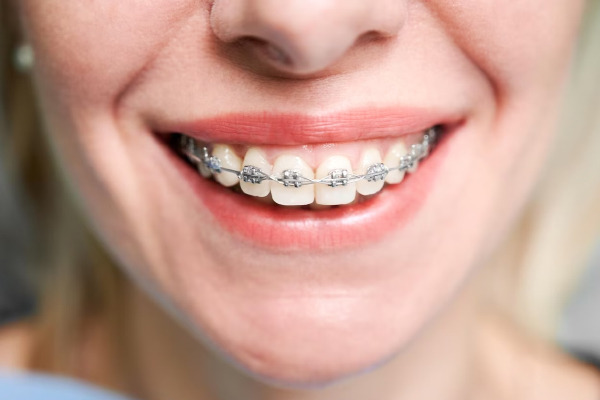 ONLINE APPOINTMENT CALL NOW
ONLINE APPOINTMENT CALL NOW ONLINE APPOINTMENT CALL NOW
ONLINE APPOINTMENT CALL NOW
Braces are orthodontic devices that correct crooked and misaligned teeth.
When people think of orthodontics, this treatment is normally the first treatment that comes to mind. Braces are used for both aesthetic and functional reasons, not only to straighten a patient’s smile but also to realign their jaw.
Braces are available for people of all ages. However, children between the ages of 10 and 14 are the most common age group to receive treatment.
Orthodontic treatment varies depending on each patient’s needs, jaw and tooth structure, and age. There are seven main braces components that connect together to realign teeth and create a healthier smile over time:
The most popular types of braces use brackets, which are small, square-shaped pieces of metal or ceramic. They are placed in the center of each tooth and are staggered depending on the patient’s needs and how their teeth are aligned.
A metal archwire passes through the center of the brackets and applies constant pressure to the teeth. The wire gradually shifts the teeth into their ideal positions.
Elastic ligatures are small rubber bands that go around each bracket. Ligatures ensure that the arch wire remains in its socket. They also help guide teeth into their correct positions. Elastics come in a variety of sizes and colors and are replaced at every orthodontic adjustment appointment.
Chain elastics or power chains replace the elastic ties on each tooth. They put even more pressure on the teeth and create a clenching force that pulls the teeth together. Typically, power chains are used at the end of treatment.
Wire ligatures are thin, stainless steel wires that hold the arch wire in place. Wires also secure individual brackets to each tooth. These can be used in place of elastic ligatures when it is difficult to retain the archwire in the bracket.
Coils, also called coil springs, are placed between two brackets when the teeth are very close together (overlap). The coils separate the teeth and restore the patient’s bite.
Rubber bands attach to the hooks and connect the top and bottom brackets together. It ensures proper alignment of teeth and helps reposition the jaw. Rubber bands are applied and removed daily by the patient.
There are many different types and over a hundred brands of braces to choose from.
More aesthetic options are available for adults who do not want visible metal braces. For example, clear ceramic braces mirror the size and shape of metal braces but are actually made of porcelain.
Four common types of braces include:
Traditional metal braces are the most effective and affordable orthodontic treatment option.
They correct overcrowding, align teeth, and reposition the jaw. An orthodontist easily moves teeth in small increments during routine checkups. For children and teenagers, traditional braces are the most popular option. There are also options for adults who don’t mind visible metal braces.
Clear braces, also called ceramic or invisible braces, are the same size and shape as metal braces and serve the same purpose.
The main difference between the two types is that clear braces have tooth-coloured brackets, meaning they blend in with natural teeth and are less noticeable. The rubber bands and elastic components of clear braces are also clear or white. Invisible braces are ideal for teens and adults.
Lingual braces are a lesser-known, alternative option to traditional metal braces. This “invisible” orthodontic treatment is similar to traditional braces. However, the main difference is that the brackets and wires are placed on the back of the teeth.
Lingual braces use the same hardware and methods as traditional “external” braces.
Clear aligners such as Invisalign are another popular “invisible” orthodontic treatment option. They are minimally invasive and removable.
They generally cost the same as traditional metal braces. Patients must wear each custom aligner for up to three weeks. Teeth move a fraction of a millimeter at a time, requiring fewer office visits. Aligners are a popular option for teens and adults.